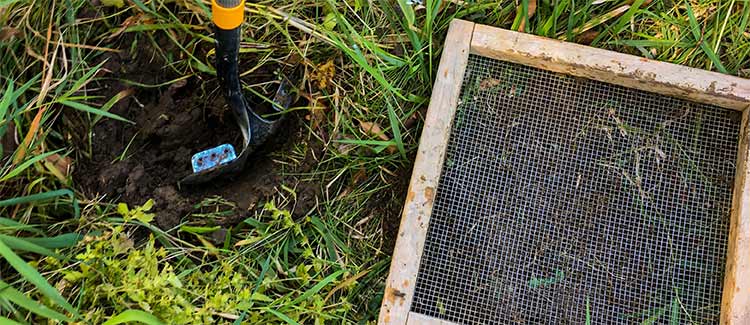Cultural Resource Management (CRM or Section 106) is often a requirement for engineering projects, especially transportation projects. Within the engineering world, federal and state compliance for cultural resources is often seen as an annoying hindrance to a project. This is especially true for larger projects within cities with historic resources or projects that require the acquisition of right-of-way. But it doesn’t have to be painful! As a Principal Investigator (qualified professional) of both architectural history and archaeology, I can provide the guidance and expertise needed to navigate the Section 106 process for Clark Dietz and our clients.
For some background, Section 106 refers to the 106th section of the National Historic Preservation Act of 1966. With the passage of this act, any project using federal money is required to take into account the effects that project will have on historic resources in and near the action area. This can include visual, auditory, and direct physical effects, improper treatment of historic properties according to the Secretary of the Interior’s established guidelines, relocation, or destruction. It also provides the general public (consulting parties) the opportunity to express their opinions, as well as the opportunity for the Advisory Council on Historic Preservation (ACHP) to weigh in. To manage these undertakings on a state level, each state has established a State Historic Preservation Office (SHPO) who oversees, reviews, and approves recommendations based on Section 106 work completed by professionals.
What does Section 106 work actually look like?
We usually start our process long before plans are finalized. For historic architecture resources, we develop an Area of Potential Effects (APE) that is large enough to take into account all of the potential effects to the project. This area varies depending on line of sight, how tall the project will be, whether the project will introduce new sounds or sights into the area, and other factors. Once the APE is established, all of the buildings that are approximately 45 years or older are surveyed with photography and written notes. These are used to compile a report detailing what is found and the recommendations for those resources. For archaeology, the APE is typically the footprint of the project or the construction limits. If the area has not been previously disturbed, a Phase I archaeological field reconnaissance is required. This is a fancy term for going out and digging small holes at pre-determined intervals to determine if any cultural resources exist within the APE. If cultural resources are found in Phase I, further work will be recommended. If determined necessary, this could go as far as a Phase III mitigation, where everything (or an agreed-upon amount) is excavated before construction.
Consulting parties are identified and invited to participate in the process, which includes those individuals and entities that might have a vested interest in what’s happening. Consulting parties can be people like county historians, other history experts (for instance, a specialist in historic bridges), local historical societies, Native American tribes, non-profits, and for-profit businesses that might be affected by the undertaking. Consulting parties have several opportunities throughout the Section 106 process to participate, which can include providing resources, commenting on the report, and being included in any discussions of mitigation possibilities.
If (based on the fieldwork and recommendations of above ground and/or below ground resources) it is determined that there will be an adverse effect to those resources, consulting parties, the SHPO, the consultant, and other federal and state agencies will work together to mitigate those effects. Mitigation can include making changes to the project plans, providing education to the general public in the form of signs, pamphlets, or websites, excavation of archaeological resources, or any other agreed-upon ideas. One of my favorite parts of the Section 106 process is the opportunity to be creative when it comes to mitigation options by working together to come up with a solution. Every project is different, and the mitigation options are wide open in most cases. In cases where there are adverse effects and mitigation is required, typically a Memorandum of Agreement (MOA) will be drafted to make sure all involved parties agree to the mitigation efforts. This must be approved by the ACHP, the SHPO, the federal agency responsible for the project, and the consulting parties.
Pictured Above: Screening dirt at the Panther Rock site in Carroll County, Kentucky c. 2008
What does this mean for engineers and their projects?
A basic understanding of the Section 106 process can be a great asset to a project manager. This will help provide a clear idea of an accurate project timeline and what to expect for cultural resource clearance. No one likes to be taken by surprise! Download this helpful flow chart to see if you’ve completed all the necessary steps to be Section 106 compliant. If a project manager can accurately predict the level of involvement for Section 106, they can plan well ahead of time for the documentation and consultation required. Of course, there are always times when surprises do pop up. There are those cases where cultural artifacts are discovered during project planning, and the project timeline must be changed to accommodate further testing or mitigation. Don’t be afraid to work with your state SHPO’s office, or your state transportation entity. These folks are well-versed in the processes, and chances are, they’ve been through a similar situation before. They are happy to provide guidance!
Clark Dietz now has a qualified architectural historian and archaeologist on staff, and we are excited to be providing cultural resources services along with the wide range of engineering services you already know and appreciate. If you are unsure about how cultural resources might impact your engineering project, we are here to help walk you through the process. Let us know how we can help you move through the required Section 106 process for your transportation or engineering projects.
Pictured Above: Cleaning up the reflecting pool at the
General Lew Wallace Study & Museum in Crawfordsville, Indiana in 2017.
Digging Deeper: Section 106 Terminology
Adverse Effect: Any alteration to the property or environment that will have a negative impact on a NRHP-listed or eligible resource.
Advisory Council on Historic Preservation: The ACHP promotes the preservation, enhancement, and sustainable use of the nation’s diverse historic resources, and advises the President and Congress on national historic preservation policy (www.achp.com).
Archaeology: The study of human culture through excavation (or study) of human material culture (artifacts) and other physical remains. Archaeology is one subset of Anthropology, which is the study of human culture. Archaeology does *not* include the study of dinosaurs, that is paleontology.
Area of Potential Effects: As per 36 CFR 800.16(d), the area of potential effects (APE) is defined as “…the geographic area or areas within which an undertaking may directly or indirectly cause alterations in the character or use of historic properties if any such properties exist. The APE is influenced by the scale and nature of an undertaking and may be different for different kinds of effects caused by the undertaking…”
Consulting Parties: Individuals or organizations with a demonstrated interest in the undertaking, including legal or economic interest, or who are concerned with the undertaking’s effects on historic properties.
Cultural Resource Management: This refers to the preservation and documentation of cultural resources such as historic buildings, archaeology sites, artifacts, and intangible resources such as folklore or oral history.
Historic Architecture: Generally speaking, for inclusion into the National Register of Historic Places (NRHP), a building, structure, or site must be 50 years or older and hold significance related to an event, place, person, style of architecture, or the potential to provide information via archaeological excavation.
Memorandum of Agreement: A legal document detailing an agreement between parties regarding the treatment of historic properties or archaeological sites. The ACHP, SHPO, responsible federal agency, consultant, and consulting parties all participate in the MOA execution.
Mitigation: Effort to reduce adverse impacts to a historic building/group of buildings, or archaeological site that is being affected by an undertaking (project).
Principal Investigator: A person or persons who meet federal and state standards to manage the Section 106 process or simply cultural resources within that particular state. Each state has its requirements to become qualified, which includes advanced degrees in history, architectural history, historic preservation, anthropology, and/or archaeology.
Secretary of the Interior: This is the office within the federal government responsible for the management of cultural resources, environmental resources, the National Park Service, and Native population resources.
Section 106: Section 106 of the National Historic Preservation Act of 1966 states that any undertaking using federal money must take into account any effects on cultural resources. This includes documentation and mitigation efforts.
State Historic Preservation Office: Section 101 of the 1966 NHPA established a state office for the management of cultural resources within each state. Because each state is responsible for maintaining this office, it looks a bit different in every state. In Indiana, the SHPO exists with the Department of Natural Resources. In Kentucky, it is within the Arts and Tourism Cabinet.
{{cta(‘f4643e54-c8bc-4ead-9c2f-f15c2c4dbe7f’)}}








